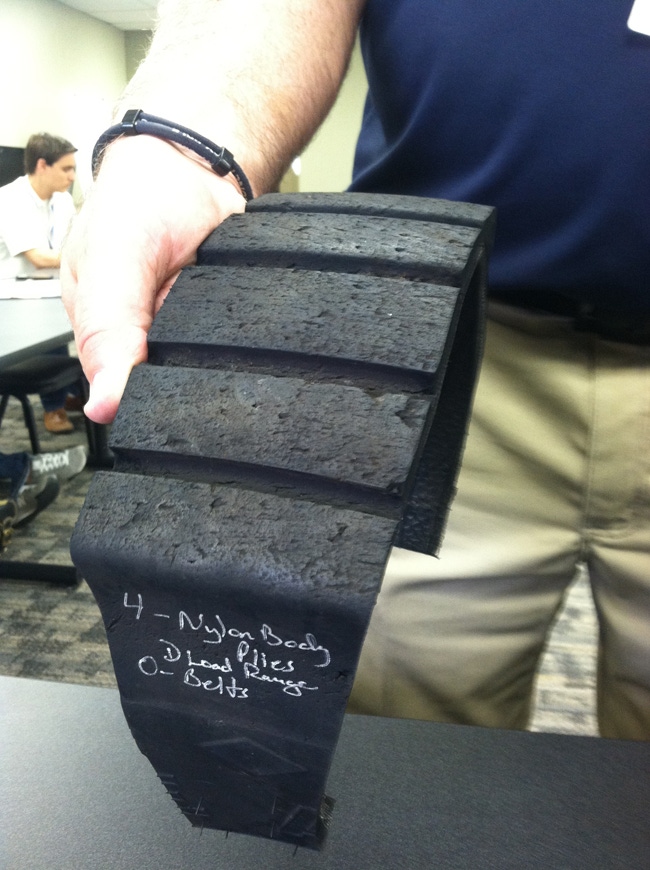June 18, 2012

Mark Dimit was growing weary of tire stalking. Despite the satisfaction and benefits this Grinnell, Iowa, corn and soybean farmer derives from genetic seed enhancements and stacked traits prevalent within the seed corn he plants today, there can also be a downside.
Primarily a minimum- and no-till producer who farms about 4,000 acres, Dimit was experiencing an increase in tire damage on several of the implements he uses on his farm. The same genetics responsible for enhancing stalk strength and increasing residue were also creating adversity by causing tire damage to his John Deere planter.
Originally, Dimit accepted the fact that tire damage resulting from stronger cornstalks and increased stubble residue was another of the many challenges in the plight of a farmer. That was until Dimit had to take his 40 ft. planter out of the fields during peak soybean planting season for three consecutive days as a result of too much stalk damage.
Frustrated and facing other springtime planting challenges, Dimit decided to take action.
“We were having flat tires on the planter nearly every day during soybean planting season,” says Dimit. “We could get by temporarily using stubble sealant, until a time when we could actually get the tires repaired. And that did help. But all the time I was thinking that someone has to come up with something better. The sealant was just a temporary fix; it wasn’t addressing the bigger issue.”
Machinery downtime is a major frustration on farm operations. While repairing a flat tire is not necessarily complicated, it can become very time-consuming.
“It’s not all that easy to get at,” says Dimit. “There is a lot of extra work, especially when you are aways from home without a shop. And it’s expensive—upwards of $35 just for tire repair alone. But the hardest part was being down for a couple hours every day. And I’m not exaggerating. You know it’s a serious problem when standard issue for the day begins with making sure there is an air compressor along when heading to the field.”
It wasn’t until Dimit, while attending a farm show, expressed his frustration to booth personnel representing Titan Tire and learned more about the tire manufacturing process.
“Here I was at this farm show complaining to the guys in the Titan Tire booth about tire quality, telling them they needed to come up with something better,” says Dimit. “When I first learned that tire selection for my planter was actually very specific, and specified by the OEM, I really didn’t have the choice to upgrade to a more durable tire, even though I was willing to pay more for something that would be able to handle the stalk punishment. The tire manufacturer’s hands were tied.”
Working with Dimit, the product research and development team from Titan Tire got busy. A prototype of a more durable tire was developed, which addressed the damage inflicted on Dimit’s planter each spring by the genetically enhanced corn stubble.
According to Skip Sagar, sales manager for Titan Tire, farmers like Dimit are simply looking for options and are willing to pay more for an alternative, provided it works.
“Mark came to us with an issue that needed to be addressed and we jumped on it as a very interested party, to try and help get the frustration resolved,” Sagar says. “We were highly motivated, as was he, and that’s why the thing worked. There really aren’t a whole lot of options out there right now and I think that’s what people — our farmer customers — are looking for. I don’t know that we have a final solution, but I think we’re being pushed in a certain direction, which we find encouraging.”
The solution, as Sagar explains, is rooted in stubble-resistant compounds that were developed nearly a decade ago. Titan Tire engineers expanded on that technology, with additional enhanced molecular materials.
While the new compounds result in a higher price for the tire, some farmers like Dimit are willing to pay for the upgrade.
“Look what I spent the first year — over $200 in repairs, not to mention the downtime,” says Dimit. “So if upgrading to a more durable tire costs me, say, $150 apiece, that’s only $600 for a $150,000 planter, just to upgrade to something that will save me time and money and a lot of frustration over the long haul. It is pretty much a no-brainer.”
You May Also Like




